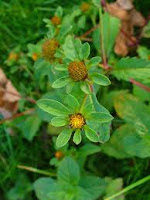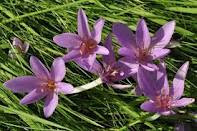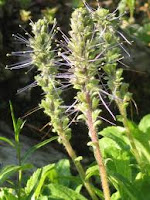In the 17th century, when Culpeper was writing his great Herbal this plant was known as water agrimony, but it is now more frequently called the bur marigold or beggarticks, this is because of the burs which are the fruit of the plant and which stick to things very easily. Culpeper says that in some countries it was called “water-hemp, bastard hemp, and bastard-agrimony; also eupatorium and hepatorium, because it strengthens the liver.” He says that the flowers have a substance in their middles which smells “like rosin, or cedar when it is burnt.”
 The bur marigold is native to Europe including the British Isles, and also West Asia. It is a member of the Asteraceae or Compositae family which is the daisy family of plants and so it is related to the ox-eye daisy, costmary, tansy, feverfew, chamomile, elecampane, purple and yellow goat’s beard, black salsify, Mouse Ear Hawkweed, pellitory, Holy thistle, marigolds, sunflowers, yarrow, groundsel, fleabane and horseweed to name but a few of its many relatives. It has leaves which are edible when cooked like spinach.
The bur marigold is native to Europe including the British Isles, and also West Asia. It is a member of the Asteraceae or Compositae family which is the daisy family of plants and so it is related to the ox-eye daisy, costmary, tansy, feverfew, chamomile, elecampane, purple and yellow goat’s beard, black salsify, Mouse Ear Hawkweed, pellitory, Holy thistle, marigolds, sunflowers, yarrow, groundsel, fleabane and horseweed to name but a few of its many relatives. It has leaves which are edible when cooked like spinach. The bur marigold flowers in August- September and then the bur-fruit appear. The flower heads yield a pale yellow dye, and other parts of the plant a black one. In China it has been used in traditional medicine for centuries for chronic dysentery and it is called longbacao, which means ‘wolf’s grasp weed’.
Nicholas Culpeper has this to say about its medicinal benefits:-
 “Government and virtues. It is a plant of Jupiter, as well as the other agrimony; only this belongs to the celestial sign Cancer. It healeth and dryeth, cutteth and cleanseth, thick and tough tumours of the breast; and for this I hold it inferior to but few herbs that grow. It helps the cachexia, or evil disposition of the body; also the dropsy and yellow jaundice. It opens obstructions of the liver, mollifies the hardness of the spleen; being applied outwardly, it breaks imposthumes; taken inwardly, it is an excellent remedy for the third-day ague; it provokes urine and the terms; it kills worms, and cleanseth the body of sharp humours, which are the cause of itch, scabs &e. The smoke of the herb, being burnt, drives away flies, wasps, &c. It strengthens the lungs exceedingly. Country people give it to their cattle when they are troubled with the cough, or brokenwinded.”
“Government and virtues. It is a plant of Jupiter, as well as the other agrimony; only this belongs to the celestial sign Cancer. It healeth and dryeth, cutteth and cleanseth, thick and tough tumours of the breast; and for this I hold it inferior to but few herbs that grow. It helps the cachexia, or evil disposition of the body; also the dropsy and yellow jaundice. It opens obstructions of the liver, mollifies the hardness of the spleen; being applied outwardly, it breaks imposthumes; taken inwardly, it is an excellent remedy for the third-day ague; it provokes urine and the terms; it kills worms, and cleanseth the body of sharp humours, which are the cause of itch, scabs &e. The smoke of the herb, being burnt, drives away flies, wasps, &c. It strengthens the lungs exceedingly. Country people give it to their cattle when they are troubled with the cough, or brokenwinded.” It was used as a styptic, which contracts blood vessels and so was used to stop bleeding both externally and internally and was thought to be excellent for dispersing stones and gravel in the internal organs. It was effective for uterine haemorrhages and was said to be effective for stomach problems such as ulcerative colitis and peptic ulcers. It was sometimes combined with ginger root in a tisane for digestive problems.
The whole plant has been used to increase the milk flow in breast-feeding mothers, as a narcotic, an astringent, antiseptic and to reduce fevers. It is harvested as the plant comes into flower.
The flowers have strong antioxidant properties and these may be used in the “pharmaceutical or food industry” according to one study by Wolniach, M. et al. “Antioxidant activity of extracts and flavonoids from Bidens tripartita” (2007). Having potent antioxidant properties mean that they have anti-cancer potential as antioxidants fight the scavenging free-radicals which cause damage to healthy cells.
“The oil exhibited a strong antifungal activity” according to another study: “Composition of the Essential Oil of Bidens tripartita L. Roots and its Antibacterial and Antifungal Activities.” Monika Tomczykowa et al. in the Journal of Medicinal Food Vol14 March 2011.
Bur marigolds have been used for centuries in traditional Polish medicine as diuretics, anti-inflammatory agents and to boost the immune system.
Other studies have shown that the methylene chloride extract inhibits the growth of cancer cell lines and there is evidence for its antimicrobial and antibacterial use in skin diseases and other Polish studies have also shown that extracts of this plant have anti-inflammatory actions.
This is another small plant which is clearly of value to us for the health benefits it can give.
































